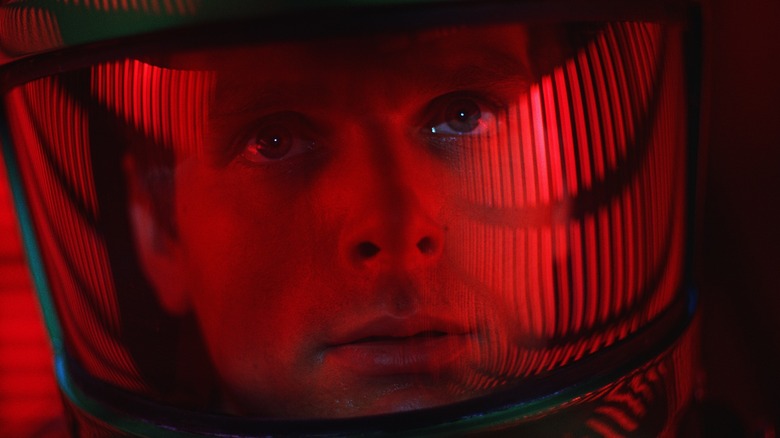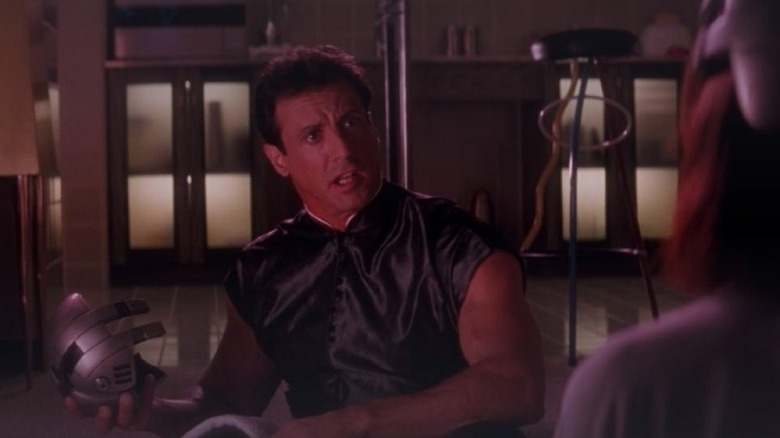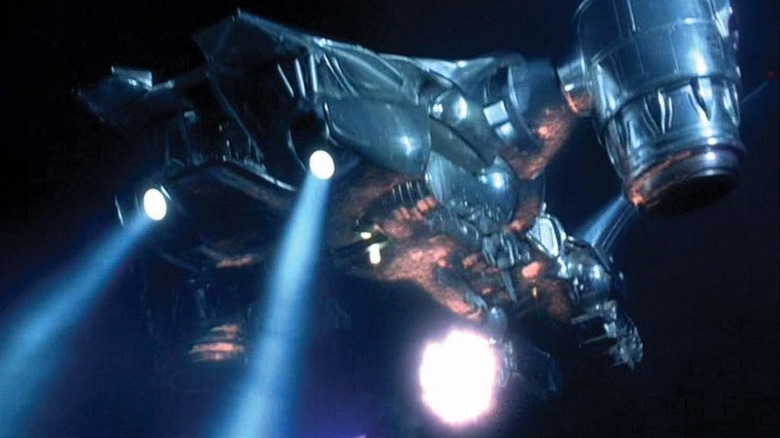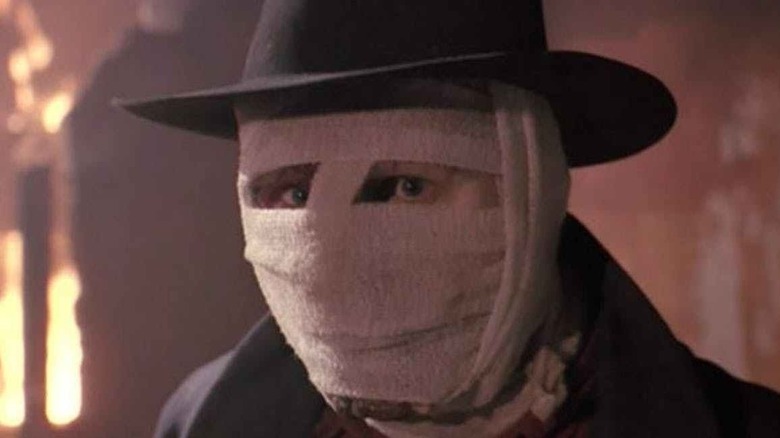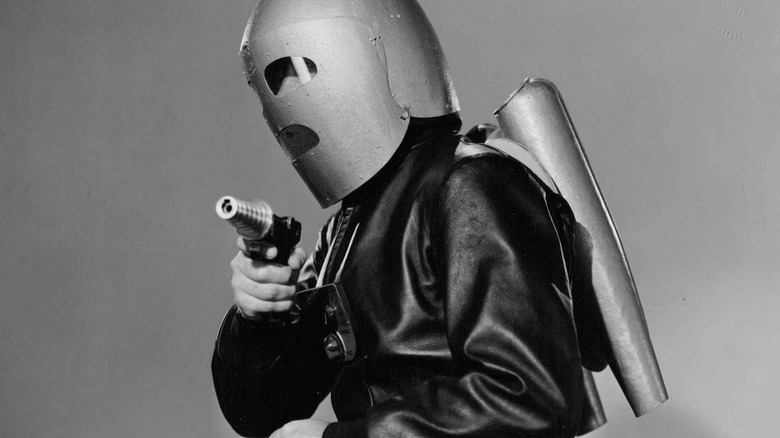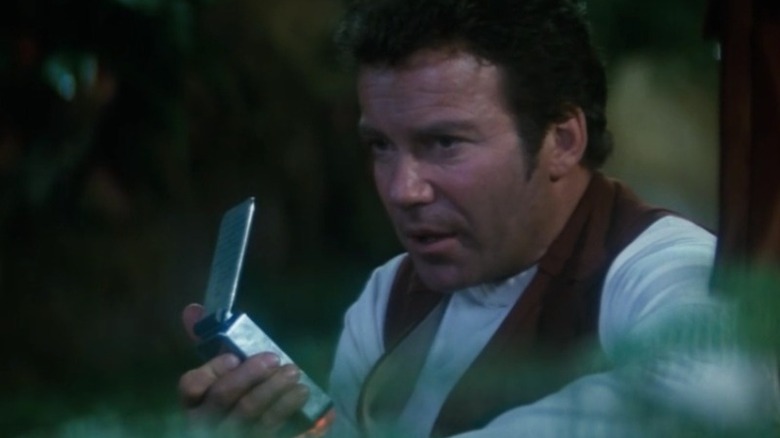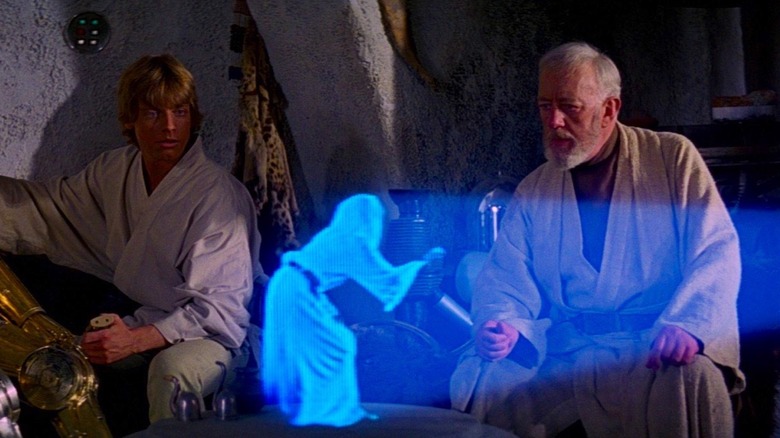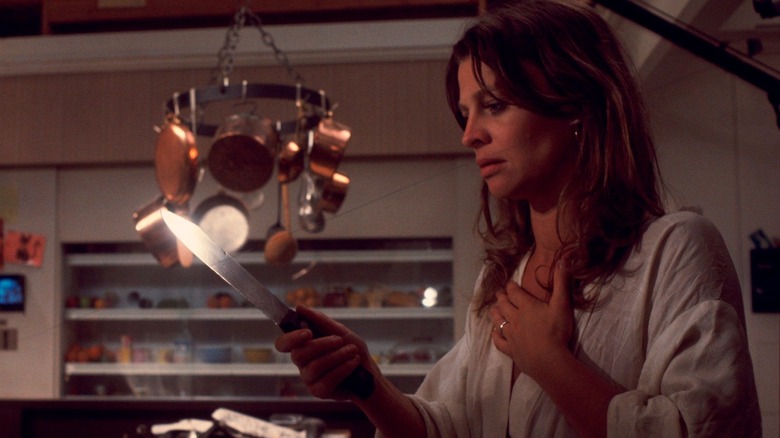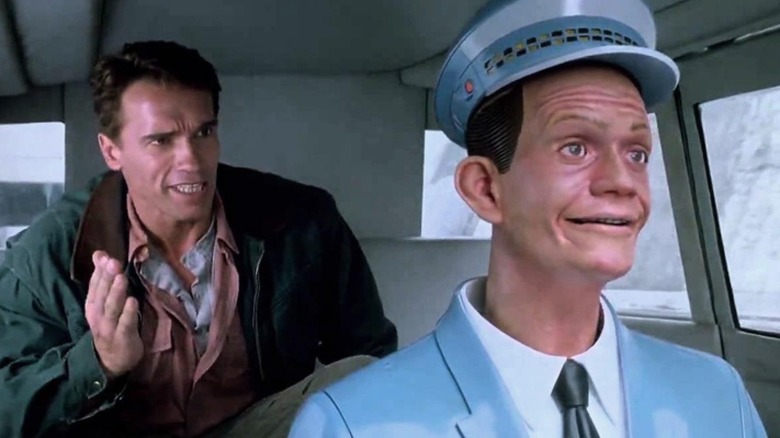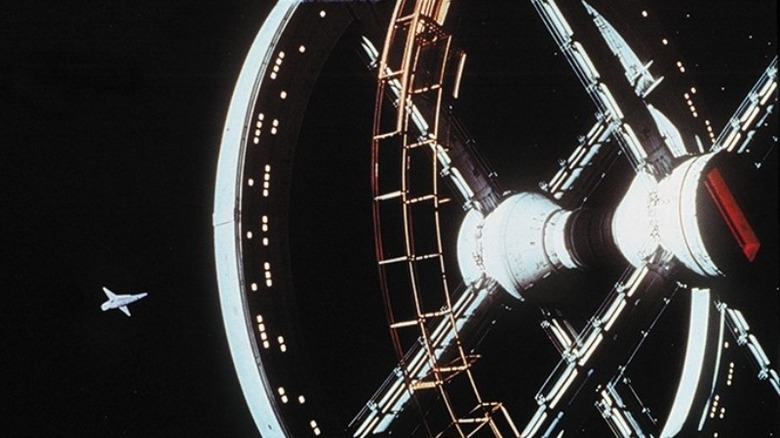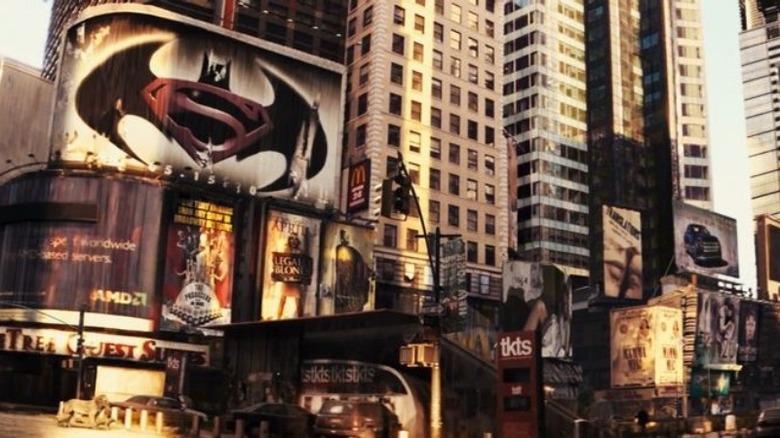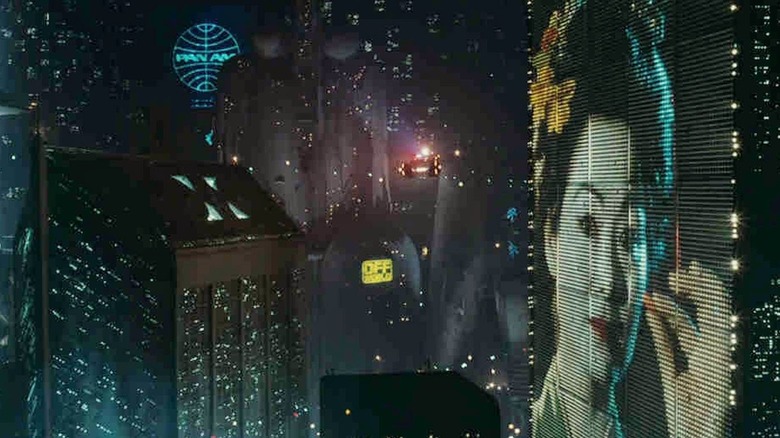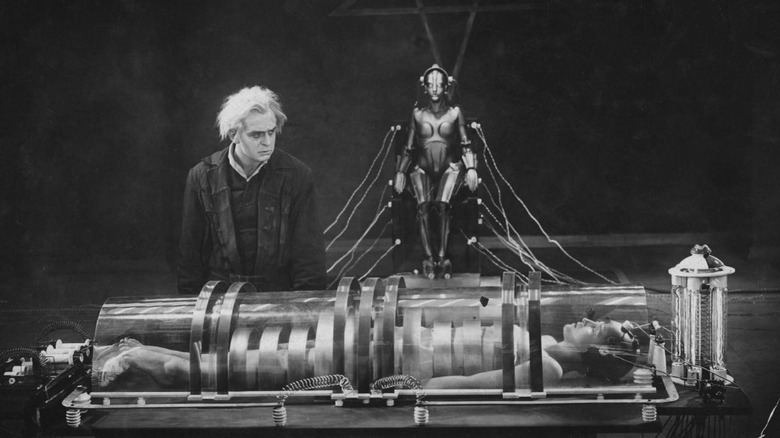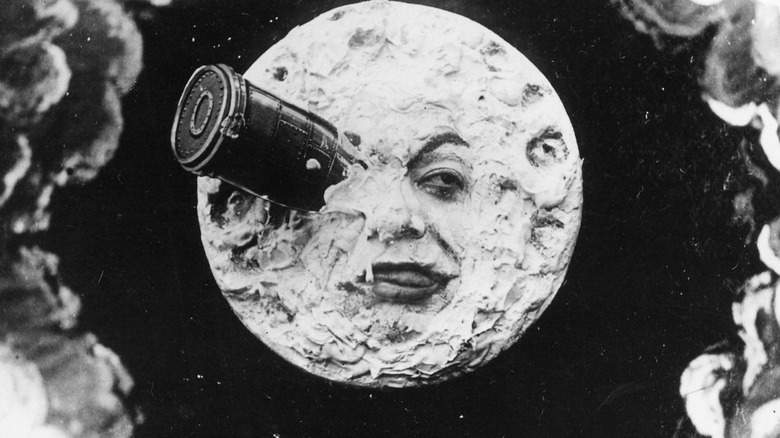Sci-Fi Movies That Became A Reality
Science fiction offers us windows through which we glimpse dazzling technology, mysterious realms, and seemingly impossible adventure. Horror and fantasy offer the same sort of storytelling, and, like science fiction, they remain perennially popular film genres. Time and again, however, science fiction distinguishes itself in a unique and fascinating way: Often, the impossibilities presented by this genre become not only possible in the real world, but utterly commonplace.
From amazing flying devices to advertising innovations to relatively mundane household items, science fiction films have predicted the technology that has become part of our lives many times over. In some cases, it isn't even technology the movies predict, but life-altering global crises and pop culture landmarks. Some sci-fi films have so correctly called future events that they almost seem like acts of supernatural prophecy. These are the most uncanny examples of sci-fi movies becoming reality, from digital billboards to space travel.
Demolition Man gave us a preview of social distancing
You don't get the sense that the 1993 sci-fi action thriller "Demolition Man" is working very hard to predict the future. To a certain extent, it shares the cartoonish, satirical tone of movies like "Robocop" and "Total Recall," and, like those films, it feels first and foremost like an action vehicle. But in April 2020, shortly after the COVID-19 pandemic hit North America, "Demolition Man" screenwriter Daniel Waters talked to Vulture about how unintentionally prophetic his story had become.
"Demolition Man" sees Officer Huxley (Sandra Bullock) explain to John Spartan (Sylvester Stallone) that physical touch is taboo in 2032 — even the act of intimacy is achieved without touch in this world. This is because a series of pandemics led to an extreme version of social distancing. Even the infamous three shells — which somehow replace toilet paper in "Demolition Man" — came to seem prophetic in 2020, considering the hoarding that led to toilet paper shortages early in the COVID-19 pandemic.
"Demolition Man" even includes the tiny detail that, by 2032, Arnold Schwarzenegger had been President of the United States. While that hasn't happened — and is currently impossible, as Schwarzenegger wasn't born in the U.S. — in 2003, Schwarzenegger did become the governor of California. Moreover, that same year, Senator Orrin Hatch tried and failed to introduce a constitutional amendment that would allow the action hero to hold presidential office.
The Terminator predicted drone tech
Quite a few sci-fi films predict a war between artificial intelligence and humanity. One of the most enduring of these films is James Cameron's 1984 smash, "The Terminator." While most of the movie's action takes place in 1984's Los Angeles, where the titular cyborg (played by Arnold Schwarzenegger) hunts Sarah Connor (Linda Hamilton), the mother of humanity's future savior, we also get flashbacks (or flash-forwards, depending on how you look at it) from the memory of time traveler Kyle Reese (Michael Biehn) of the war between humans and machines. Among the combatants in the conflict are unmanned drones raining bullets on human rebels from the safety of the sky.
Aerial drones were actually in military use long before "The Terminator." For example, the U.S. used drones for reconnaissance in the Vietnam War, and Israel used assault drones against Syria in 1982. However, since then, drones have become a more frequently used and controversial tool of the U.S. military. Moreover, drone technology is so commonplace that private citizens can purchase drones in stores or over the Internet.
Darkman showed us what 3-D printers could do
Long before he helped bring Spider-Man to the big screen, director Sam Raimi brought us a much grimmer and more violent hero in 1990's "Darkman." Played by Liam Neeson, the eponymous vigilante begins as pioneering scientist Dr. Peyton Westlake. He initially cares little about fighting criminals, being chiefly concerned with a new process he's created to generate synthetic skin for burn victims. After suffering the terrible injuries that turn him into Darkman, he uses this same process in order to replace his own scarred face.
In spite of hitting theaters decades ago, the tech Westlake uses to create synthetic skin is essentially 3-D printing. While we're not quite there yet, scientists are closer than you probably realize to being able to create functioning human organs with 3-D printing technology, including skin. For example, the American Society for Medical Engineers (ASME) reported in March 2020 that a team at the Wake Forest Institute for Regenerative Medicine in Winston-Salem, North Carolina "is growing viable tissue and organs for patients" with 3-D printing, coupled with a process called electrospinning. Some of these organs, per ASME, will be ready for clinical trials by 2022.
King of the Rocket Men introduced audiences to jetpacks
Back in the days of black and white serials, moviegoers got their first chance at seeing a hero fight evildoers with the aid of a jetpack. In 1949's "King of the Rocket Men," Jeff King (Tristram Coffin) uses a jetpack, a bucket-like helmet, and a ray gun to battle the servants of the evil Dr. Vulcan. The jetpack has remained a staple of movies for years, returning in films like the 1965 James Bond entry "Thunderball" and 1991's "The Rocketeer." This left us all to wonder, of course, when we'd all get our own personal jetpacks.
In fact, jetpacks are here — and they've been with us a while. As Dave Hall outlines in a 2018 article for The Guardian, as early as 1961, engineer Harold Graham was able to lift off the ground for 13 seconds with aid of the "Jet Belt." More recent examples include the rocket-propelled jetpack flown by pilot Bill Suitor during the 1984 Olympics, and the jetpack Yves "Jetman" Rossy uses to fly, though he needs to first throw himself out of a plane to perform his aerial feats.
So far, the biggest problem with jetpacks is cost. As Hall notes, of those few jetpack-like devices on the market, most cost around $200,000. Moreover, those who have already flown the devices aren't confident your average person could safely operate them. Suitor said plainly, "I hope they never become popular. Nobody would be safe."
Star Trek helped inspire multiple technological advances
Few entertainment franchises have acted as the conceptual starting point of so many real-world technological advances as "Star Trek." The media behemoth's many films, beginning with 1979's "Star Trek: The Motion Picture," are practically a parade of gadgets that went from being the stuff of fanciful sci-fi to totally commonplace.
The most obvious example is the device you may very well be reading this on: the mobile phone. The very first cell phone was invented by Martin Cooper, who was inspired by the communicators of "Star Trek." The "Star Trek: The Next Generation" era of the franchise introduced the PADD, which helped inspire touch screen tablets like the iPad. Digitally accessible music on board the Enterprise gave Karlheinz Brandenburg — inventor of the MP3 — the idea for his innovation.
Ever wonder how people from different worlds are able to understand one another in "Star Trek"? It's all thanks to a fictional device called the Universal Translator, which isn't quite so fictional anymore. While they aren't exactly universal, digital pocket translators exist that are just about the next best thing.
Star Wars showed us 3-D holograms and bionic limbs
Some people, including George Lucas himself, might tell you "Star Wars" isn't really science fiction, but a fantasy story in a sci-fi-like setting. But for our purposes, we're going with the camp that says the incalculable influence of "Star Wars" changed the very definition of the genre to include it. In truth, the fact that there are real-life technological innovations directly inspired by these films can be seen as pretty big evidence that it deserves inclusion.
In the first "Star Wars" film, Princess Leia Organa (Carrie Fisher) is able to contact the Jedi-in-hiding Obi-wan Kenobi (Alec Guinness) by way of a 3-D hologram recording, projected from the droid R2-D2. Similar holograms appear throughout the films, including ones allowing characters to communicate in real time. Speaking in 2018 of a technique called volumetric display, which creates 3-D images capable of being observed from any angle, Glasgow physicist Miles Padgett singled out the Leia hologram from "A New Hope" for comparison, saying it "[gives] you an all-round view, a Princess Leia-style display."
Nor should we forget the bionic limb Luke gets to replace the one he loses to his father in "Empire Strikes Back." Bionic limbs are now a reality, including Mobius Bionics' LUKE Arm, which is actually named after Mark Hamill's iconic hero.
Demon Seed gave us a dark preview of smart home tech
While movies like "The Terminator" and "The Matrix" are well-known for their dire depictions of artificial intelligence, they were hardly the first sci-fi films to explore the subject. Case in point: The 1977 sci-fi horror flick "Demon Seed," whose villainous A.I. Proteus IV takes over the functions of its creator's home.
While Proteus IV's methods of manipulation don't resemble the tech most people use in their homes, "Demon Seed" is possibly the first example of a sci-fi movie predicting the arrival of "smart home" technology. The film is absolutely full of technology available today, including remotely controlled alarms, doorbell cameras, window and door locks, and lights. We're hoping smart home packages will never include Proteus IV's innovations, which include the ability to decapitate visitors and create cyborg offspring. But in more benevolent ways, the film accurately predicts what's quickly becoming commonplace in our homes.
Total Recall hilariously predicted driverless cars
If you're familiar with the 1990 sci-fi action flick "Total Recall," then no doubt you remember Johnny Cab. The automated taxi service is a popular transportation choice on the Earth of 2084: These self-driving cars are equipped with an animatronic "driver" sporting a face reminiscent of a young Don Knotts. One of the most memorable images from the film is a scorched "Johnny," moments after trying to run over Quaid (Arnold Schwarzenegger) for skipping out on his fare, saying, "We hope you enjoyed the ride! Ha ha!"
While they're not exactly filling streets just yet (and we certainly hope they won't be programmed to run over fare dodgers), self-driving or driverless cars are no longer a thing of the distant future. In 2020, Elon Musk announced Tesla is working on a taxi service of self-driving cars. Self-driving tech has, in fact, been included in every Tesla vehicle since 2016. In April 2021, Domino's announced it would be testing out food delivery via self-driving car in the Woodland Heights neighborhood of Houston, Texas. Because of the complex tasks these cars need to achieve, we're still some years off from driverless cars becoming a regular, everyday thing. But make no mistake: That day is coming, with or without Don Knotts dummies.
2001: A Space Odyssey gave us an early look at space stations
Stanley Kubrick's visionary 1968 epic, "2001: A Space Odyssey," includes quite a few tech predictions that have wound up becoming reality. For example, there's the video conferencing Dr. Floyd (William Sylvester) takes advantage of to talk to his family, which is now a reality — even a necessity — for many people. There's the A.I. assistant HAL, though thankfully, our Amazon Echos and Google Homes aren't quite so ... homicidal. There's also Space Station 5, which orbits the Earth and is used as a jumping-off point for other parts of the solar system. The station is based on a concept designed by NASA scientist Wernher von Braun for a space station that would create artificial gravity by continually spinning.
While there were no space stations in 1968 when "2001" hit theaters, humanity didn't have long to wait to see one in action. Three years later, in April 1971, Salyut, the first space station, was put into orbit by the Soviet Union. Salyut would be followed by stations put into orbit by the Soviet Union, China, and the United States, including the International Space Station, whose orbital construction began in 1998 and finished in 2011.
I Am Legend includes an ad for a certain superhero movie
One of the strangest examples of a sci-fi movie accurately predicting the future takes place in the 2007 post-apocalyptic thriller "I Am Legend." In one scene, Dr. Robert Neville (Will Smith) walks through a desolate, abandoned Times Square. As always, Times Square is decorated with dozens of ads. One of the most prominent is a billboard displaying what appears to be a crossover movie between DC Comics heroes Batman and Superman. "Batman v Superman: Dawn of Justice" would hit theaters in 2016, while "I Am Legend" came out in 2007, and most of the film is set in 2012. Was this a coincidence, or did the "I Am Legend" filmmakers have inside info about the coming DCEU? According to "I Am Legend" director Francis Lawrence, it's a bit of both — but the "inside info" doesn't work the way you might think.
In 2014, Lawrence explained to Collider that one of the screenwriters for "I Am Legend," Akiva Goldsman, was tapped in the early '00s to work on a "Batman vs. Superman" film which was eventually scrapped. Lawrence said neither he nor Goldsman knew anything about "Dawn of Justice," and included the logo as an in-joke about the unmade movie.
Memorable Blade Runner shots predicted digital billboards
Thankfully, humanity has yet to create synthetic beings like those in 1982's "Blade Runner," who are capable of passing as human and are pressed into slave labor. But that doesn't mean we can leave "Blade Runner" out of a discussion of sci-fi movies that predicted the future.
Like a lot of science fiction films of the time, "Blade Runner" accurately predicts a future filled with video conferencing. While Deckard (Harrison Ford) doesn't seem to have any handheld devices that he can make video calls with, he's able to pay for a quick video call with Rachael (Sean Young) from a nightclub, and makes a video call to the apartment where replicant Pris (Daryl Hannah) is hiding, just before the film's climax. Deckard also enjoys at least one or two perks of smart home tech, as we see he has voice-activated lights in his apartment.
The massive digital billboards that characterize the film's setting have also become the stuff of daily life. The Federal Highway Administration ruled digital billboards could be used on highways in 2007, and they've since become commonplace, allowing for billboards to cycle through different ads. Busy city centers like New York City's Times Square sometimes feature dozens of digital ads, including video of such quality, it puts the snacking woman of "Blade Runner" to shame.
The robots of Metropolis are becoming a reality
Any lover of science fiction cinema should know the name "Metropolis" — and no, not as it relates to Superman. A landmark in the genre, 1927's "Metropolis" includes many hallmarks familiar to science fiction fans: A vast urban dystopia, corporate takeover of almost every aspect of life, and, of course, a robot. In fact, "Metropolis" features one of the very first screen appearances of a fictional robot. The vengeful and power-hungry inventor Rotwang (Rudolf Klein-Rogge) borrows the likeness of an influential workers' rights activist for his robot creation, and uses it to cause chaos in the massive city.
We hope mad, robot-centric scientists will keep their destructive fantasies to themselves, because as every year passes, robots become more a part of our lives. For example, Honda's ASIMO, which looks like a cartoonish astronaut, can respond to questions, recognize postures and gestures, and is equipped with sensors that allow it to walk around unaided. Unveiled in 2013, Boston Dynamics' Atlas can not only walk, but also perform surprisingly acrobatic feats, like cartwheels and back flips. In 2018, Japanese roboticist Dr. Hiroshi Ishiguro introduced the world to the news-reading Erica, which he called "the most human-like autonomous android in this world."
Le Voyage dans la Lune showed us a trip to the Moon decades before it happened
In 1902, French filmmaker Georges Méliès debuted his silent film, "Le Voyage dans la Lune," or, in English, "A Trip to the Moon." It joins a group of ambitious astronomers as they decide to become the first humans to visit the Moon. They build a bullet-shaped capsule, which reaches the Earth's natural satellite after being fired from a cannon into the eye of the legendary Man on the Moon. Before escaping back to Earth, the astronomers meet the Moon's king and queen and battle an army of insectoid aliens.
While it didn't bear too much resemblance to the trip depicted in "Le Voyage dans la Lune," on July 20, 1969, American astronaut Neil Armstrong became the first man to set foot on the Moon. Though what's depicted in "Le Voyage dans la Lune" has little to do with reality, not every aspect of the story is completely nuts. In particular, the notion of using cannons to fire objects into orbit has been given serious consideration by scientists, most notably in the HARP Project, a joint American-Canadian program in the '60s that fired satellites into the upper atmosphere using enormous guns.
